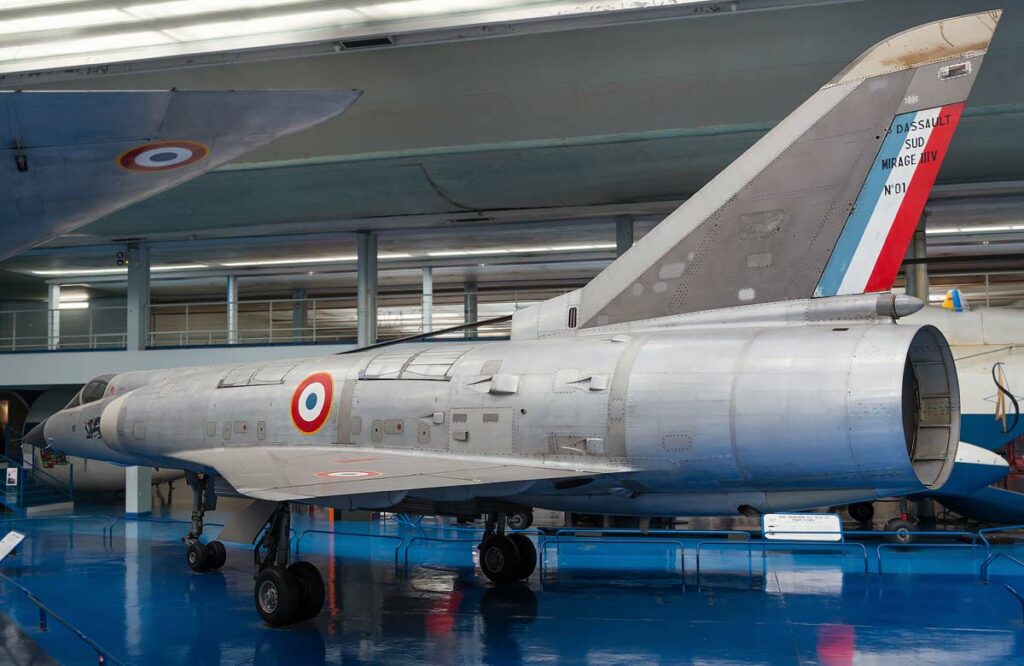The Dassault Mirage IIIV was a French experimental VTOL aircraft, blending jet-powered lift with high-speed supersonic capabilities.
In Brief
The Dassault Mirage IIIV was an innovative VTOL (Vertical Take-Off and Landing) prototype developed in the 1960s, designed to combine the vertical lift capability of a helicopter with the speed and range of a fighter jet. It featured eight small vertical lift engines and one main horizontal engine, enabling it to take off and land vertically while achieving supersonic speeds in level flight. The aircraft was part of a broader effort to create a versatile fighter that could operate from improvised bases and small carriers, enhancing operational flexibility. Despite demonstrating significant technological advances, the Mirage IIIV program was eventually discontinued due to complexities and high costs, but it contributed valuable insights into VTOL technologies and supersonic flight.
The Dassault Mirage IIIV stands as a testament to the innovative spirit of aviation during the Cold War, representing a bold attempt to fuse VTOL capability with the performance of a supersonic jet.
History of the Development of the Dassault Mirage IIIV
During the 1960s, the era of rapid technological advancements in aviation, there was a growing interest in developing aircraft that combined the vertical takeoff and landing (VTOL) capabilities of a helicopter with the speed, agility, and range of fixed-wing aircraft. The French government, recognizing the potential strategic advantage of such aircraft, initiated the Mirage IIIV program, led by the renowned Dassault Aviation.
The objective was clear: create a fighter aircraft that could operate without the need for long runways, making it less vulnerable to attack and capable of operating from improvised bases or small aircraft carriers. Dassault’s response was the Mirage IIIV, an experimental aircraft that integrated both VTOL and conventional flight capabilities, aiming for supersonic speeds.
The program was launched in the early 1960s, with the prototype making its maiden flight on February 12, 1965. Although the Mirage IIIV did not have a specific NATO nickname, its development was closely watched by military aviation circles worldwide, given its potential to revolutionize air operations.
Design of the Dassault Mirage IIIV
The Mirage IIIV was a blend of innovative design elements and advanced engineering. It was equipped with a Pratt & Whitney TF104 turbofan engine for horizontal flight and eight Rolls-Royce RB.162-1 turbojets for vertical lift, housed in the fuselage. This configuration allowed the aircraft to perform vertical takeoffs and landings, transitioning to high-speed, high-altitude flight.
The airframe was designed to be aerodynamically efficient at supersonic speeds while still accommodating the lift engines without compromising too much on weight and complexity. The aircraft featured a delta wing configuration, characteristic of Dassault’s Mirage family, providing the necessary lift and stability for both modes of flight.
However, the design was not without its drawbacks. The inclusion of multiple engines led to increased weight, complexity, and maintenance challenges. Moreover, the VTOL capabilities necessitated compromises in terms of fuel capacity and payload, limiting its operational range and combat effectiveness.

Performance of the Dassault Mirage IIIV
In terms of performance, the Mirage IIIV showcased remarkable capabilities for its time. The aircraft successfully demonstrated VTOL operations and transitioned to supersonic flight, reaching speeds of Mach 2.04 in level flight. The innovative propulsion system allowed for a maximum takeoff weight of approximately 20,000 kilograms, with the lift engines providing the necessary thrust for vertical takeoffs and landings.
When compared to its contemporaries, the Mirage IIIV was a significant technological leap forward, showcasing a potential new direction for fighter aircraft development. However, its operational range and payload capacity were limited compared to conventional supersonic fighters, primarily due to the weight and space taken up by the VTOL system.
Variants of the Dassault Mirage IIIV
The Mirage IIIV program consisted primarily of two prototypes: the initial Mirage IIIV-01, which focused on testing the VTOL capabilities, and the subsequent Mirage IIIV-02, which aimed to refine the design and improve overall performance. While there were no further variants developed, these two prototypes provided critical data and insights into the integration of VTOL technology with supersonic aircraft design.
Military Use and Combat of the Dassault Mirage IIIV
The Dassault Mirage IIIV, being an experimental prototype, was never used in combat or deployed operationally. Its primary role was to serve as a technology demonstrator, exploring the feasibility and practicality of combining VTOL and supersonic flight in a single airframe. The valuable data and lessons learned from the Mirage IIIV program influenced future VTOL research and contributed to the broader understanding of integrating different flight technologies in military aircraft.
The Dassault Mirage IIIV was a groundbreaking project that pushed the boundaries of aviation technology during its time. While it did not enter production or see operational service, its legacy lies in the invaluable insights it provided into the challenges and possibilities of VTOL supersonic flight. The program’s contributions to aerospace engineering, particularly in the realm of multi-role combat aircraft, remain significant, highlighting the innovative spirit and technical prowess of Dassault Aviation and the broader aviation community of the era.
Back to the experimental aircraft section.